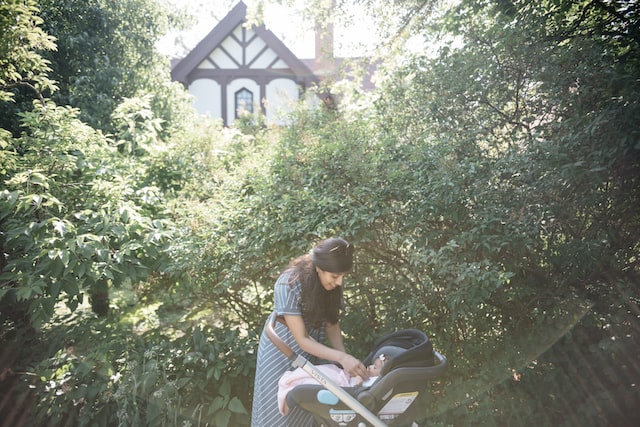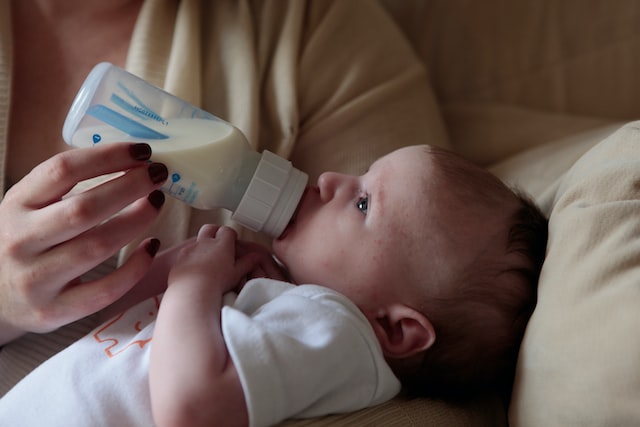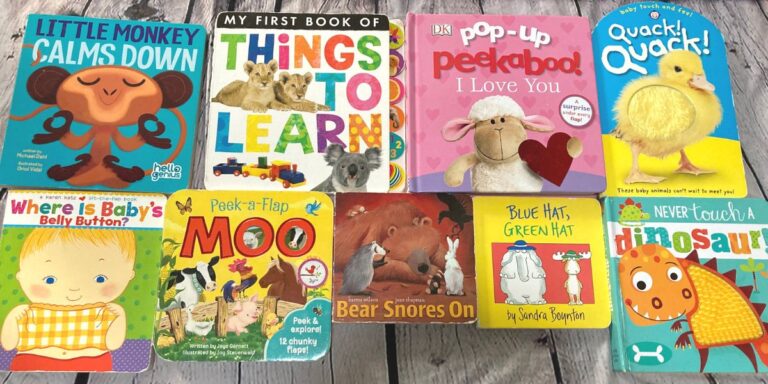4 Month Old Daily Schedule
At 4 months old you may finally be coming out of the postpartum survival stage and really beginning to see a little personality coming from your baby. You may just start to understand how your baby feeds, sleeps and plays and may start to finally get into a routine. Read on to see our 4 month old daily schedule and read what works in our house for baby (with two older siblings).
Keep in mind I do not have a sleep certification, am not a pediatrician, and am simply a Mom of three littles sharing what works in our home. This schedule is what works best for us, bearing in mind that my 4 month old is a cat napper and takes some very short naps many days.
This schedule also may work some days and not others. 4 month old babies sometimes have a mind of their own (often) and I find it works best to go with the flow and be willing to change things up if the need arises. All babies are different and what works for one baby may not always work for other babies.
Along these same lines know that whatever works for your baby (bottle feeding, breastfeeding, holding for naps, napping in a bassinet, stroller naps, carrier naps, outside play, etc…) is what is best for your baby and you are doing a great job!
*This post may contain affiliate links and as an Amazon Associate and a member of other affiliate programs, I may earn a small compensation from qualifying purchases. All opinions and recommendations are my own.

1. Sleep Schedule
According to WebMD, at 4 months old, your child will need anywhere between 14-16 hours of sleep including nap times and bedtime.
This means that a typical bedtime for a 4-month-old should be anywhere between 6 and 8 pm depending on when your child wakes up. At 4 months you may start to easily recognize your little one’s sleepy cues. Red eyebrows, yawning, crying/crankiness, and drooping eyes are what we start to see when our 4-month-old gets tired.
Try to stick to a similar bedtime each night. But know that at this age it may change depending on wake-up times from nap. Our bedtime usually varies by 30 minutes either way depending on how his last nap goes.
Usually, a 4-month-old’s wake windows are anywhere from 1.5 hours to 2 hours. We like to put our little one down around 1.5 hours after he last wakes up. This helps so that he isn’t overtired and goes down easier. We find that if we go towards two hours he gets overtired and it becomes harder to put him down.
You may need to play with your little one’s wake windows or explore to find out what works for them at this age.

2. 4-Month-Old Activity Time
Many 4 month old babies are just starting to grab onto toys and play using their hands. It is a great time for exploration, new textures, and practice skills like rolling over. Infants don’t need a lot of fancy toys to play.
Exploring their hands, feet, and bodies is great play for a 4 month old baby as well. Some great things to do with babies this age are take them outside for walks, lay them down for tummy time and allow them to practice rolling over, give them toys such as rattles, balls, and baby keys, and let them play on a play mat.
Toys for Independent Play:
Toys are great tools to encourage independent play for 4-month-olds (but are not necessary if you don’t have the budget for them). While independence is hard at this level you are still able to get a few minutes by surrounding them with toys for independent play.
Some of the toys we like best are shown below including a fun play mat, baby keys, a sit-me-up chair, things that shake and make noise like rattles, and things that are easy to grab on and put in their mouth.
Things to Do and Places to Take Your 4-Month-Old
While 4 Months is a little small to really get out and explore their surroundings you can still help them grow and learn by exposing them to new things and experiences.
We love to take our 4 month old places where they can get fresh air, see family and friends, and interact with other caregivers or babies. A daily walk is almost always a must if the weather allows it but see below for some of the other fun places we enjoy taking our little one:
- Zoo visit – watching the animals move around and hearing the noises they make.
- Local library story time- listening to a caregiver read books, seeing the pictures, and interacting and playing with other babies/toys.
- Playgroup and/or play date- we joined an amazing stay-at-home mom’s Facebook group that sets you up with other moms and events for kids going on in the area. Great for socializing for Mom and meeting new friends to grow up with for baby.
- Family visit – visit grandparents/cousins/other families at home
For more fun places to go and things to do with your 4 month old baby check out this list of 108 awesome things to do as a Stay at home mom.

3. Eating Schedule for a 4 Month Old
By the age of four months, you may finally have a hold on your little one’s eating and how often they need to eat in order to be content, full, and happy. You have probably decided what works best for your family whether it be bottle feeding, pumping, breastfeeding, or a combination of different methods. Whatever you do and find works best for your baby is best for them.
In our home, we find our 4 month old prefers to eat every 2-3 hours when he is awake. This is also what worked best for our girls when they were the same age. He is a quick eater and is usually finished eating within 10 minutes. He still wakes to eat at least once or twice a night and that works for us.
We follow the baby’s feeding cues to know how often he needs to eat. He usually tries to eat his hands or a shoulder, or someone holding him when he is hungry. We also see him start to get fussier or rooting if he is hungry.

4. Sample Schedule for a Four Month Old
Here is an example of our day with a 4 month old that cat naps. You will notice he will take about 30-40 minute naps if left alone. Because our day allows it we hold our baby during the afternoon nap to extend his sleep and allow him to sleep longer as well as get some extra snuggle time.
We also almost always do a nap in the baby carrier or car seat for the second nap of the day because we are usually on the go picking up our older one from school, keeping our girls occupied, or running errands. This may not work in your schedule so do what works best for you.
- 2:30 – Feed and back to sleep
- 5:00 – Feed and back to sleep
- 7:30 – Wake-up, feed
- 7:45 – Dress, diaper change, get ready for the day
- 8:00 – Indoor playtime/tummy time – See lists above for some fun toys and other ideas for this.
- 9:00 – Nap #1 – In crib
- 9:30 – Wake up, feed
- 9:45 – Walk around the neighborhood, shopping, or other “out of home” activity
- 11:00 – Nap #2 – In crib or in a carrier or car seat if on the go and needed
- 11:45 – Wake up, feed
- 12:00 – Lunch for self and older children while baby plays in a reclined high chair or on the play mat
- 12:30 – Begin nap routine with older children including books. The baby joins for books and does tummy time once they are asleep.
- 1:15 – Nap #3 – In crib for the first part
- 1:45 – Nap #3 continued in arms
- 3:00 – Wake up, feed
- 3:15 – Indoor or outdoor playtime/tummy time
- 4:45 – Nap #4 – In baby carrier while making dinner or crib nap
- 5:15 – Wake up, feed
- 5:30 – Dinner for family, baby plays in a reclined high chair near the table
- 6:00 – Family walk, older sibling sports, or indoor time on the mat or playing while held
- 6:45 – Bath time
- 7:00 – Bedtime routine: storytime, pajamas, feed, rock, and snuggles
- 7:15 – Bedtime
- 8:00 – Wake up and feed back to sleep for the night

5. Sample Schedule for a Four Month Old (Longer Napper)
- 2:30 – Feed and back to sleep
- 5:00 – Feed and back to sleep
- 7:30 – Wake-up, feed
- 7:45 – Dress, diaper change, get ready for the day
- 8:00 – Indoor playtime/tummy time – See lists above for some fun toys and other ideas for this.
- 9:00 – Nap #1 – In crib
- 11:00 – Wake up, feed
- 11:15 – Walk around the neighborhood, shopping, or other “out of home” activity
- 12:00 – Lunch for self and older children while baby plays in a reclined high chair or on the play mat
- 12:30 – Begin nap routine with older children including books. The baby joins for books and does tummy time.
- 12:45 – Feed
- 1:00 – Nap #2 – In crib
- 3:00 – Wake up, feed
- 3:15 – Indoor or outdoor playtime/tummy time
- 4:45 – Nap #3 – In baby carrier while making dinner or crib nap
- 5:30 – Wake up, feed
- 5:45 – Dinner for family, baby plays in a reclined high chair near the table
- 6:15 – Family walk, older sibling sports, or indoor time on the mat or playing while held
- 7:00 – Bath time
- 7:15 – Bedtime routine: storytime, pajamas, feed, rock, and snuggles
- 7:30 – Bedtime

Overall, these are just two different sample schedules for 4 month old babies based on how we go about our days at our house. We almost always aim to go for a walk or out-of-home activity if the weather permits it.
There is no right or wrong way to go about your day with your baby. Do what works best for you. As you can see our 4-month-old dictates roughly how his day goes. He is a cat-napper, still wakes up to feed at night, and almost always “false starts” before bedtime meaning he goes to bed but wakes up shortly after once before really going down.
He loves being held for naps and will nap longer if he is in his arms or the carrier. He goes with the flow and we simply adjust his schedule to work with his older siblings while still making sure he gets what he needs.
4 Months old is a super fun age as they are starting to interact and play with toys, open up to people and smile/laugh for the first time, roll over, and see more. We love our little 4-month-old but some days can be tough. Hopefully, this schedule can help you see what a day in the life of a 4-month-old may look like!
If you have a 1 year old at home and are looking for sample schedules be sure to also check out our sample schedules for a 1 year old.










This was super thorough and so much more realistic than a few other posts I’ve come across. Thank you so much! I’m a first time mom and our baby turns 4-months this coming week so I’m really happy I came across your post! I can’t wait to try this out 🥰
Thanks so much! We tried to stick with what was realistic for our babies as well. Hope it helps!